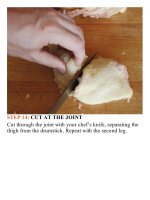The food lab better home cooking through science ( PDFDrive ) 54
Bạn đang xem bản rút gọn của tài liệu. Xem và tải ngay bản đầy đủ của tài liệu tại đây (266.77 KB, 2 trang )
WhichKnifeStyleIsSuperior?
T
he difference between Japanese- and Western-
styleknivesusedtobenightandday.Westernknives
had gently sloped, curved blades that came to a
point,witharelativelythickspinecomparedtotheir
length,andcouldrockonacuttingboard.Japanesestyle knives had flat blades made for slicing and
chopping, not rocking, with a slender profile and a
relativelylightweight.
These days, the divide is not so clear. Western
knife makers now offer santoku-style knives,
referring tothe staple knife of the Japanese home
cook. Even knives with aWestern shape have been
slimmed down and made lighter in response to a
growing market of folks used to the easier-tomaneuver Japanese-style blades. Japanese knife
makers, on the other hand, have begun applying
their skills togyutou,Western-styleknivesproduced
with Japanese forging techniques to make what can
oftenbethebestofbothworlds.
So which style is the best? There is no right
answer to that. I first learned to cook with the
Western-styleknivesthateveryonewasusingatthe
time,somyearlyknifecollectionmostlyconsistedof
heavy German knives like Wüsthofs and Henckels.
But as I began experimenting with Japanese-style
knives, I found that I much preferred the precision
they offered, and that their inability to perform
rocking tasks like mincing was worth the trade-off
for me. These days, I use a mix of Western- and
Japanese-styleknives.
AWestern-stylechef’sknifehasacurved,tapered
blade.
AJapanese-stylesantokuknifehasastraightercutting
edgeandablockiertip.









